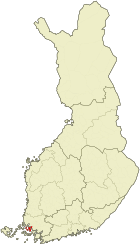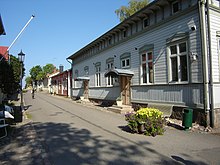Naantali
| coat of arms | map |
|---|---|

|

|
| Basic data | |
| State : |
|
| Landscape : | Varsinais-Suomi |
| Administrative community : | Turku |
| Geographical location | 60 ° 27 ′ N , 22 ° 2 ′ E |
| Surface: | 638.08 km² |
| of which land area: | 283.47 km² |
| of which inland waterways: | 4.03 km² |
| of which sea area: | 350.58 km² |
| Residents : | 19,245 (Dec. 31, 2018) |
| Population density : | 67.9 inhabitants / km² |
| Municipality number : | 529 |
| Language (s) : | Finnish |
| Website : | naantali.fi |
Naantali [ ˈnɑːntɑli ] ( Swedish Nådendal ) is a city in southwest Finland with 19,245 inhabitants (as of December 31, 2018). It is located on the Baltic coast in the Varsinais-Suomi landscape not far from Turku . Naantali is one of the oldest cities in Finland and is now an important port and a popular tourist destination thanks to its picturesque wooden old town.
geography
Position and extent
Naantali is located in the Varsinais-Suomi region in southwest Finland, around 15 km west of the city of Turku . The actual city is on the mainland on the coast of the Baltic Sea . Since Merimasku , Rymättylä and Velkua were incorporated into Naantali in 2009, a large area in the offshore archipelago belongs administratively . This area extends up to 25 km west of Naantali and is interspersed with thousands of skerries and cliffs. The island of Luonnonmaa , located directly opposite the city center, and the island of Otava to the west of it, are connected to the mainland by bridges. The rural archipelago takes up most of the administrative urban area of Naantali, while two thirds of the population live in the core city on the mainland. Naantali has a total area of 638.35 km², excluding the marine areas, it is 287.55 km².
The neighboring communities of Naantali are on the mainland Masku in the north and Raisio in the east. Towards the sea, the city is bordered by Turku in the southeast, Pargas in the south and Kustavi and Taivassalo in the northwest.
City structure
Before Merimasku, Rymättylä and Velkua were incorporated, Naantali was divided into 21 districts, of which twelve are on the mainland and nine on the island of Luonnonmaa:
|
Mainland (total 12,207 inhabitants):
|
Luonnonmaa (total 1,697 inhabitants):
|
history

Naantali originated in the Middle Ages around a Birgitten monastery founded in 1443 . This had the Latin name Vallis Gratiae ("Gnadental"). The letters V and G in the coat of arms of Naantali are reminiscent of the Latin name. The Swedish form of the name Nådendal is a literal translation of Vallis Gratiae , while the Finnish Naantali is a corruption of the Swedish name. Both men and women lived in the monastery. The monk Jöns Budde translated religious texts from Latin into Swedish in the Naantali monastery at the end of the 15th century; This makes him the first author in Finnish literary history to be known by name. The Swedish King Christoph III. had granted the Naantali Monastery trading rights, which is why a town soon developed around the monastery. In the Middle Ages, Naantali was an important place of pilgrimage.
The importance of the monastery ended with the Reformation . It was closed after the last nun died in the late 16th century. The demise of the monastery and a devastating fire in 1628 hit Naantali hard. A large part of the monastery buildings fell into disrepair, only the monastery church - to this day the main church Naantalis - has been preserved. In times of economic depression, the citizens of the city earned their living with sock knitting, an art that they had learned from the nuns of the Birgittenkloster. At the Diet of 1723 it was even proposed to revoke Naantali city rights. The proposal failed, however, and the city was consolidated again through the construction of a customs house in the middle of the 18th century.
The healing power of the Viluluoto spring near Naantali had already been discovered in the 18th century. In 1863, during the period of Russian rule, a sanatorium was built there. As a health resort, Naantali experienced a new boom. The city is still a popular travel destination today. In 1922 the Kultaranta manor on the island of Luonnonmaa off Naantali became the summer residence of the Finnish President . The settlement of industry and the boom of the port after the Second World War allowed the city to prosper economically and made Naantali the second richest (measured by tax income) city in Finland today.
In 1964, the rural community Naantali was incorporated, which expanded the urban area of Naantalis to include the island of Luonnonmaa and the area north of the city center. At the beginning of 2009, the communities of Rymättylä , Merimasku and Velkua , located in the archipelago off the Naantali coast, were incorporated into Naantali. As a result, the population of Naantalis rose by about a third, and the area has more than quintupled.
Attractions
The old town of Naantali lies below the monastery church at the city's marina. It consists of low wooden houses from the 18th and 19th centuries. The church of Naantali was built in 1480 to 1490 and originally served as a monastery church. The medieval stone church was given its present form in 1797 with the addition of a baroque church tower.
Tourist attractions in Naantali include the offshore archipelago, a spa and the Muumimaailma ( Moomin World ) amusement park, which is especially popular with children .
The Naantalin Musiikkijuhlat music festival with classical and serious music has been held in Naantali in summer since 1980 . There is also a festival on the dormouse day.
economy
In addition to tourism, heavy industry is an important industry in Naantali. There is a power station and an oil refinery in the city. The port of Naantali is the third largest cargo port in Finland after the ports of Helsinki and Kotka , and car ferries also operate from there to Kapellskär, Sweden .
Town twinning
-
 Vadstena , Sweden
Vadstena , Sweden -
 Nordfyns Kommune , Denmark
Nordfyns Kommune , Denmark -
 Svelvik , Norway
Svelvik , Norway -
 Vesturbyggð , Iceland
Vesturbyggð , Iceland -
 Puck , Poland
Puck , Poland -
 Kirovsk , Russia
Kirovsk , Russia
Personalities
Sons and daughters
- Fredrika Wilhelmina Carstens (1808–1888), writer
- Jukka Vilander (born 1962), ice hockey player
- Cristal Snow , electro musician
More people
Worked in Naantali without being born there:
- Jöns Budde (~ 1437–1491), monk
- Ilmari Manninen (1894–1933), ethnographer, worked as a teacher in Naantali, founder of the city museum
Web links
- The City website (English)
Individual evidence
- ↑ Maanmittauslaitos (Finnish land surveying office): Suomen pinta-alat kunnittain January 1, 2010 . (PDF file; 194 kB)
- ↑ Statistical Office Finland: Table 11ra - Key figures on population by region, 1990-2018
- ↑ As of 2008, source: Maanmittauslaitos (Finnish land surveying office) (PDF file; 241 kB)
- ↑ City of Naantali: Väestö osa-alueittain December 31, 2006 ( Memento of the original from May 30, 2008 in the Internet Archive ) Info: The archive link has been inserted automatically and has not yet been checked. Please check the original and archive link according to the instructions and then remove this notice. (Finnish)
- ^ Carl Magnus Creutz: De initiis monasterii Vallis Gratiae: disputatio historica. Frenckel, Helsigfors 1850 ( digitized, Google, full view ).

